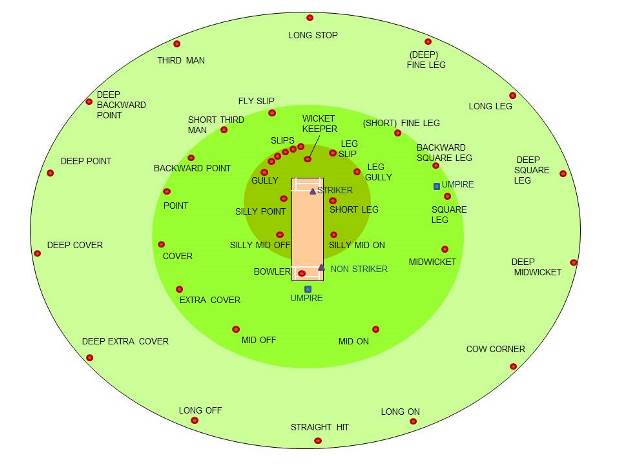Fielding (cricket): Difference between revisions
imported>John Leach (adding diagram) |
imported>John Leach (image needs to be large as it will be the focal point of the completed article (a picture says a thousand words)) |
||
| Line 4: | Line 4: | ||
The cricket field is a large grassy area, normally some 150–160 yards in diameter. One of the fielders is the bowler and another is the [[wicket-keeping (cricket)|wicket-keeper]], a specialist who stands directly behind the [[wicket (cricket)|wicket]] that the batsman on strike is defending. The batsman can hit the ball to any part of the field which means that the other nine fielders have a lot of ground to cover. | The cricket field is a large grassy area, normally some 150–160 yards in diameter. One of the fielders is the bowler and another is the [[wicket-keeping (cricket)|wicket-keeper]], a specialist who stands directly behind the [[wicket (cricket)|wicket]] that the batsman on strike is defending. The batsman can hit the ball to any part of the field which means that the other nine fielders have a lot of ground to cover. | ||
[[Image:Fielding position diagram.jpg| | [[Image:Fielding position diagram.jpg|center|thumb|1050px|Fielding positions in cricket]] | ||
Revision as of 06:17, 7 November 2018
In the sport of cricket, one of the teams during play is known as the fielding side while their opponents are batting. All eleven members of the fielding team are usually on the field throughout the innings with two batsmen and both of the two umpires. The fielding team are led and directed by their captain, who is responsible for all tactical decisions, though these are normally made after consultation with other team members, especially the bowler. The most common and most important decisions made by the captain are how to deploy his fielders around the field of play in order to assist the bowler in achieving dismissals of the batsmen and to restrict the batting team's scoring opportunities.
The cricket field is a large grassy area, normally some 150–160 yards in diameter. One of the fielders is the bowler and another is the wicket-keeper, a specialist who stands directly behind the wicket that the batsman on strike is defending. The batsman can hit the ball to any part of the field which means that the other nine fielders have a lot of ground to cover.
